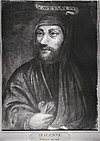Avicenna Mausoleum
 Mausoleum of Avicenna | |
 | |
| Location | Avicenna Square, Hamadan, Iran |
|---|---|
| Designer | Hooshang Seyhoun |
| Type | Mausoleum and Museum |
| Height | 28 meters |
| Beginning date | 1950 |
| Opening date | 29 April 1954 |
| Dedicated to | Avicenna |
 |
| Part of a series on |
| Avicenna (Ibn Sīnā) |
|---|
| Works |
| Thoughts |
| Pupils |
| Monuments |
The Mausoleum of Avicenna (Persian: آرامگاه بوعلیسینا) is a monumental complex located at Avicenna Square, Hamadan, Iran.
Dedicated to the Persian polymath Avicenna, the complex includes a library, a small museum, and a spindle-shaped tower inspired by the Ziyarid-era Kavus Tower.[1]
History[edit]
The Pahlavi government had plans to build the mausoleum since at least 1939. Houshang Seyhoun won competitions for the mausoleums of Ferdowsi and Avicenna before heading to France. He completed his training at the Ecole des Beaux-Arts in 1948 with the project "Le mausolée d'Avicenne à Hamadan."[2] The mausoleum was eventually dedicated in a grand ceremony in May 1954, and the avenue running in front of it was also renamed in honor of Avicenna.[3]
As the monument was by the Pahlavi government, it was consequently in danger of being defaced, but as Khomeini himself was an admirer of Avicenna, the square was not renamed after the 1979 Revolution.[4]
Gallery[edit]
-
Mausoleum of Avicenna
-
Mausoleum of Avicenna
-
Outside view
-
A model of the complex
-
An interior view
-
The old mausoleum drawn by Charles Heath
-
Avicenna Mausoleum on the reverse of a 1954 10 Iranian rial banknote
-
Avicenna Mausoleum on the reverse of a 1981 200 Iranian rial banknote
References[edit]
- ^ Thresholds 24, Massachusetts Institute of Technology, Department of Architecture, 2002, p. 49.
- ^ Salari Sardari, Mohadeseh (2024-03-04). "Andre Godard and Maxime Siroux: Disentangling the Narrative of French Colonialism and Modern Architecture in Iran". Iranian Studies: 1–29. doi:10.1017/irn.2024.10. ISSN 0021-0862.
- ^ Jay M. Rasooli, Cady Hews Allen, The Life Story of Dr. Sa'eed of Iran, William Carey Library, 1983, 161f.
- ^ Thresholds 24, Massachusetts Institute of Technology, Department of Architecture, 2002, p. 48. "At the core of the Pahlavi 'pride,' around which the imagined Iranian nation was exulted before the Revolution, the tomb complex came under the risk of state vandalism between 1978 and 1980."
- Pope, Arthur Upham. Persian Architecture. Tandem Verlag GmbH., 2007.










